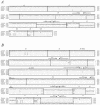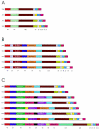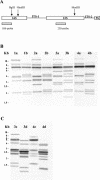Variation in 16S-23S rRNA intergenic spacer regions in Photobacterium damselae: a mosaic-like structure
- PMID: 15691912
- PMCID: PMC546723
- DOI: 10.1128/AEM.71.2.636-645.2005
Variation in 16S-23S rRNA intergenic spacer regions in Photobacterium damselae: a mosaic-like structure
Abstract
Phenotypically, Photobacterium damselae subsp. piscicida and P. damselae subsp. damselae are easily distinguished. However, their 16S rRNA gene sequences are identical, and attempts to discriminate these two subspecies by molecular tools are hampered by their high level of DNA-DNA similarity. The 16S-23S rRNA internal transcribed spacers (ITS) were sequenced in two strains of Photobacterium damselae subsp. piscicida and two strains of P. damselae subsp. damselae to determine the level of molecular diversity in this DNA region. A total of 17 different ITS variants, ranging from 803 to 296 bp were found, some of which were subspecies or strain specific. The largest ITS contained four tRNA genes (tDNAs) coding for tRNA(Glu(UUC)), tRNA(Lys(UUU)), tRNA(Val(UAC)), and tRNA(Ala(GGC)). Five amplicons contained tRNA(Glu(UUC)) combined with two additional tRNA genes, including tRNA(Lys(UUU)), tRNA(Val(UAC)), or tRNA(Ala(UGC)). Five amplicons contained tRNA(Ile(GAU)) and tRNA(Ala(UGC)). Two amplicons contained tRNA(Glu(UUC)) and tRNA(Ala(UGC)). Two different isoacceptor tRNA(Ala) genes (GGC and UGC anticodons) were found. The five smallest amplicons contained no tRNA genes. The tRNA-gene combinations tRNA(Glu(UUC))-tRNA(Val(UAC))-tRNA(Ala(UGC)) and tRNA(Glu(UUC))-tRNA(Ala(UGC)) have not been previously reported in bacterial ITS regions. The number of copies of the ribosomal operon (rrn) in the P. damselae chromosome ranged from at least 9 to 12. For ITS variants coexisting in two strains of different subspecies or in strains of the same subspecies, nucleotide substitution percentages ranged from 0 to 2%. The main source of variation between ITS variants was due to different combinations of DNA sequence blocks, constituting a mosaic-like structure.
Figures





Similar articles
-
Characterization of the 23S and 5S rRNA genes and 23S-5S intergenic spacer region (ITS-2) of Photobacterium damselae.Dis Aquat Organ. 2004 Oct 21;61(1-2):33-9. doi: 10.3354/dao061033. Dis Aquat Organ. 2004. PMID: 15584408
-
Analysis of 16S-23S rRNA gene internal transcribed spacer of Vibrio anguillarum and Vibrio ordalii strains isolated from fish.FEMS Microbiol Lett. 2009 Oct;299(2):184-92. doi: 10.1111/j.1574-6968.2009.01755.x. Epub 2009 Aug 11. FEMS Microbiol Lett. 2009. PMID: 19732149
-
16S-23S rDNA internal transcribed spacer regions in four Proteus species.J Microbiol Methods. 2009 Apr;77(1):109-18. doi: 10.1016/j.mimet.2009.01.024. Epub 2009 Feb 8. J Microbiol Methods. 2009. PMID: 19318046
-
[The 16S-23s rRNA intergenic spacer regions of mycoplasmas].Nihon Saikingaku Zasshi. 1996 Feb;51(2):583-8. doi: 10.3412/jsb.51.583. Nihon Saikingaku Zasshi. 1996. PMID: 8752381 Review. Japanese. No abstract available.
-
Revisiting the genus Photobacterium: taxonomy, ecology and pathogenesis.Int Microbiol. 2017 Mar;20(1):1-10. doi: 10.2436/20.1501.01.280. Int Microbiol. 2017. PMID: 28581017 Review.
Cited by
-
Species-Specific Identification of Streptococcus based on DNA Marker in 16S-23S rDNA Internal Transcribed Spacer.Curr Microbiol. 2020 Aug;77(8):1569-1579. doi: 10.1007/s00284-020-01975-8. Epub 2020 Apr 6. Curr Microbiol. 2020. PMID: 32253469
-
Reverse Engineering Targets for Recombinant Protein Production in Corynebacterium glutamicum Inspired by a Fast-Growing Evolved Descendant.Front Bioeng Biotechnol. 2020 Dec 9;8:588070. doi: 10.3389/fbioe.2020.588070. eCollection 2020. Front Bioeng Biotechnol. 2020. PMID: 33363126 Free PMC article.
-
Microdiversity of deep-sea Bacillales isolated from Tyrrhenian sea sediments as revealed by ARISA, 16S rRNA gene sequencing and BOX-PCR fingerprinting.Microbes Environ. 2013;28(3):361-9. doi: 10.1264/jsme2.me13013. Epub 2013 Sep 5. Microbes Environ. 2013. PMID: 24005887 Free PMC article.
-
Photobacteriosis: prevention and diagnosis.J Immunol Res. 2014;2014:793817. doi: 10.1155/2014/793817. Epub 2014 May 28. J Immunol Res. 2014. PMID: 24982922 Free PMC article. Review.
-
Recombination drives evolution of the Clostridium difficile 16S-23S rRNA intergenic spacer region.PLoS One. 2014 Sep 15;9(9):e106545. doi: 10.1371/journal.pone.0106545. eCollection 2014. PLoS One. 2014. PMID: 25222120 Free PMC article.
References
-
- Baylis, H. A., and M. J. Bibb. 1988. Organization of the rRNA genes in Streptomyces coelicolor A3(2). Mol. Gen. Genet. 211:191-196. - PubMed
-
- Bentley, R. W., and J. A. Leigh. 1995. Determination of 16S rRNA gene copy number in Streptococcus uberis, S. agalactiae, S. dysgalactiae, and S. parauberis. FEMS Immunol. Med. Microbiol. 12:1-8. - PubMed
-
- Buck, J. D., N. A. Overstrom, G. W. Patton, H. F. Anderson, and J. F. Gorzelany. 1991. Bacteria associated with stranded cetaceans from the northeast USA and southwest Florida Gulf coasts. Dis. Aquat. Org. 10:147-152.
Publication types
MeSH terms
Substances
Associated data
- Actions
- Actions
- Actions
- Actions
- Actions
- Actions
- Actions
- Actions
- Actions
- Actions
- Actions
- Actions
- Actions
- Actions
- Actions
- Actions
- Actions
LinkOut - more resources
Full Text Sources
Other Literature Sources

